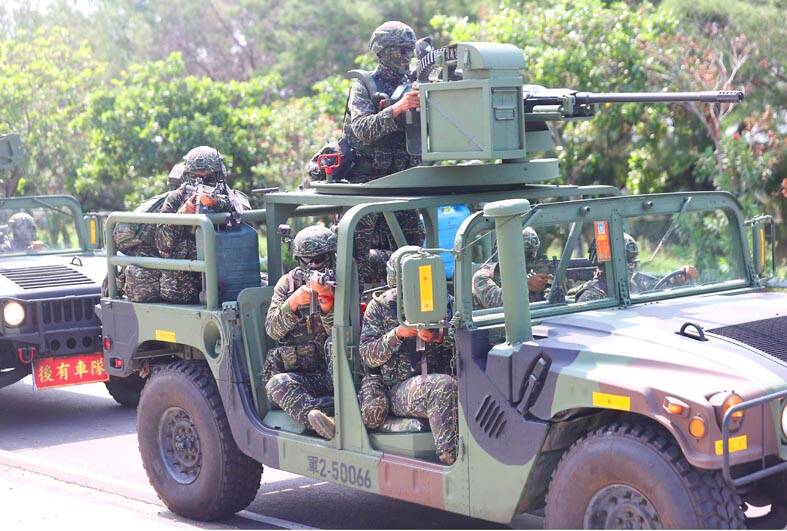The military yesterday held a series of air defense drills, including an evacuation and relocation of the air force’s Taipei command headquarters, on the second day of the live-fire phase of the annual Han Kuang exercises.
Due to Typhoon Doksuri, the scale of warplane deployments and air raid drills has been adjusted, military personnel familiar with the exercises said.
The primary purpose of the exercises was to test cross-branch air defense capabilities, several unnamed military sources said.

Photo: CNA
The joint operation saw the air force and navy deploy truck-mounted anti-air missile defense systems, including the Hsiung Feng (“Brave Wind”), Patriot PAC-2 and Tien Kung (“Sky Bow”), to conduct anti-aircraft and ballistic missile drills nationwide, the sources said.
The air force yesterday morning also completed a round of exercises simulating the relocation of the Joint Air Operations Command Center from Toad Mountain (蟾蜍山) in Taipei in the event of an attack, the sources said.
To ensure there would be no interruption in the chain of command in terms of air defense, military personnel stationed at Toad Mountain, commonly known as “the nerve center of Taiwan’s air force,” were relocated to an undisclosed alternative location to continue carrying out their mission, the sources added.
The military has at least three alternative command center locations in northern, southern and eastern Taiwan, they said.
The military yesterday also simulated the defense of critical infrastructure in cooperation with local police forces, firefighters and the Coast Guard Administration.
Meanwhile, the army’s attention was focused on a temporary coastal fortification system near a northern port that could be critical in repelling a Chinese attack.
Part of a response to a simulated invasion by China’s military, the 150m-long trench near the Port of Taipei in New Taipei City’s Bali District (八里) was built by reservists from the army’s 109th Infantry Brigade with help from civilian contractors, a military spokesperson said at the site.
This year’s trench system was significantly larger than the 100m-long trench system built a year ago for the Han Kuang exercises in Bali, the spokesperson said.
Similar to last year, it is located under a section of the elevated Provincial Highway 61 to take advantage of a forest surrounding the Port of Taipei.
The forest and the elevated expressway make the defensive stronghold less likely to be detected, giving infantry positioned inside the trench system a better chance of eliminating invading enemy forces using anti-armor weapons, the spokesperson said.
The location also has strategic significance, serving as a key defensive position for fending off a potential People’s Liberation Army invasion of Taiwan by sea, the spokesperson added.
Defending the area near the mouth of the Tamsui River has always been a priority for the military because if enemy forces were to take it, they could easily advance into Taipei and important political and economic facilities.
The trenches are big enough to be stocked with ammunition and supplies, artillery, rockets, machine guns and rifles, but because this year’s fortification is bigger, it can also house M60A3 battle tanks, providing more offensive power with which to deter or repel an enemy invasion.
The live-fire component of this year’s Han Kuang military exercises began on Monday with the focus of the first day testing the military’s preservation and maintenance of combat capabilities in the event of a full-scale Chinese invasion.
This year’s tabletop exercises were staged in May.

Taiwanese were praised for their composure after a video filmed by Taiwanese tourists capturing the moment a magnitude 7.5 earthquake struck Japan’s Aomori Prefecture went viral on social media. The video shows a hotel room shaking violently amid Monday’s quake, with objects falling to the ground. Two Taiwanese began filming with their mobile phones, while two others held the sides of a TV to prevent it from falling. When the shaking stopped, the pair calmly took down the TV and laid it flat on a tatami mat, the video shows. The video also captured the group talking about the safety of their companions bathing

US climber Alex Honnold is to attempt to scale Taipei 101 without a rope and harness in a live Netflix special on Jan. 24, the streaming platform announced on Wednesday. Accounting for the time difference, the two-hour broadcast of Honnold’s climb, called Skyscraper Live, is to air on Jan. 23 in the US, Netflix said in a statement. Honnold, 40, was the first person ever to free solo climb the 900m El Capitan rock formation in Yosemite National Park — a feat that was recorded and later made into the 2018 documentary film Free Solo. Netflix previewed Skyscraper Live in October, after videos

Starting on Jan. 1, YouBike riders must have insurance to use the service, and a six-month trial of NT$5 coupons under certain conditions would be implemented to balance bike shortages, a joint statement from transportation departments across Taipei, New Taipei City and Taoyuan announced yesterday. The rental bike system operator said that coupons would be offered to riders to rent bikes from full stations, for riders who take out an electric-assisted bike from a full station, and for riders who return a bike to an empty station. All riders with YouBike accounts are automatically eligible for the program, and each membership account

A classified Pentagon-produced, multiyear assessment — the Overmatch brief — highlighted unreported Chinese capabilities to destroy US military assets and identified US supply chain choke points, painting a disturbing picture of waning US military might, a New York Times editorial published on Monday said. US Secretary of Defense Pete Hegseth’s comments in November last year that “we lose every time” in Pentagon-conducted war games pitting the US against China further highlighted the uncertainty about the US’ capability to intervene in the event of a Chinese invasion of Taiwan. “It shows the Pentagon’s overreliance on expensive, vulnerable weapons as adversaries field cheap, technologically